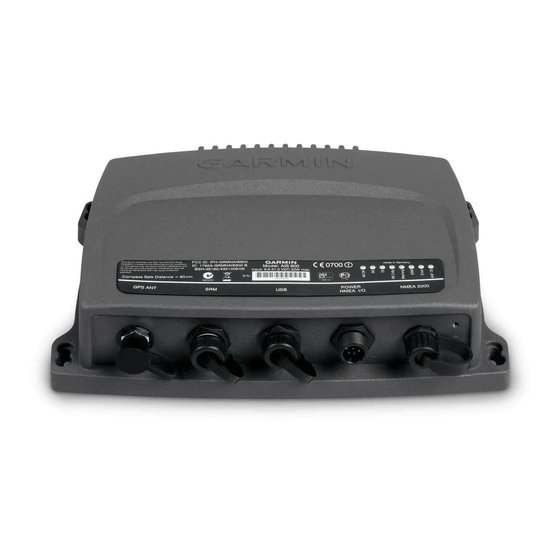Garmin AIS 600 Manuale di istruzioni - Pagina 6
Sfoglia online o scarica il pdf Manuale di istruzioni per Attrezzatura marina Garmin AIS 600. Garmin AIS 600 13. Automatic identification system (ais) class b transponder device
Anche per Garmin AIS 600: Riferimento tecnico (42 pagine), Dichiarazione di conformità (6 pagine)

•
If the AIS 600 is wired to a non-Garmin NMEA 0183 chartplotter, or not wired to a chartplotter at all, then you must install a toggle switch
to turn the device on and off.
◦
Connect the yellow wire from the AIS 600 power/data cable to one terminal of a single-pole, single-throw switch (not included), and
connect the other terminal to the negative (-) battery terminal.
◦
When you close the switch, the AIS 600 powers on. When you open the switch, the AIS 600 powers off.
Installing the GA 30 GPS Antenna
You must install the included GA 30 GPS antenna and connect it to the AIS 600 according to the following instructions. The AIS 600 will not
transmit a signal unless the GA 30 is installed properly and receiving a satellite signal.
The AIS 600 does not accept GPS information from any other GPS device or antenna on the boat. Also, the AIS 600 does not share GPS
information from the GA 30 antenna with any other device on the boat.
You can surface mount the GA 30 antenna or attach the antenna to a standard 1 in. OD (14 threads per inch) pipe-threaded-pole marine mount
(not included).
Select a suitable location for the GA 30 antenna on your boat. To ensure the best reception,
mount the GA 30 antenna in a location with a clear view of the sky in all directions.
•
Avoid mounting the GA 30 antenna in the shade of the superstructure of the boat, a radome
antenna, or a mast.
Mount the GA 30 antenna at least 3 ft. (1 m) away from (preferably above) the path of
•
any radar beam or a VHF radio antenna.
Temporarily secure the antenna in the preferred mounting location and test it for correct
operation. If you experience interference from other electronics, try a different location. When
you verify correct operation, permanently mount the antenna.
Surface-mounting the GA 30 Antenna
1 Use the surface-mount bracket as a mounting template.
•
Use a center punch to mark the three screw locations on the surface.
•
Use a pencil to trace the cable hole in the center of the bracket.
•
Set the surface-mount bracket aside. Do not drill through the surface-mount bracket.
2. Drill
/
in. (3 mm) pilot holes at the three marked locations.
1
8
NotE: If you are mounting the GA 30 on fiberglass, it is recommended that you
use a countersink bit to drill a clearance counterbore through the top gelcoat layer
(but no deeper). This will help to prevent cracking in the gelcoat layer when the
screws are tightened.
3. Use a 1 in. (25 mm) hole saw to cut the cable hole in the center.
4. Place the seal pad on the bottom of the surface-mount bracket. Ensure that the
screw holes align.
5. Use the included M4 screws to attach the surface-mount bracket to the mounting
surface.
6. Route the cable through the 1 in. (25 mm) cable hole and connect it to the GA 30.
7. Ensure that the large rubber gasket is in place on the bottom of the GA 30
antenna, place the antenna on the surface-mount bracket
antenna clockwise to lock it in place
8. Secure the antenna to the mounting bracket with the included M3 set screw
9. Route the cable away from sources of electronic interference, and connect it to the
AIS 600 using the BNC connector.
6
➊
, and twist the
.
➋
EMI
EMI
EMI (Electromagnetic Interference)
EMI (Electromagnetic Interference)
Above - best
Above - best
Below - OK
Below - OK
Radar
Radar
GA 30 Antenna Placement Considerations
GA 30 Antenna Placement Considerations
➊
➊
Surface-mount
Surface-mount
bracket
bracket
Mounting
Mounting
➌
.
surface
surface
Better
Better
Best
Best
Good
Good
from engine components
from engine components
ft.
ft.
(1 m)
(1 m)
VHF Radio Antenna
VHF Radio Antenna
➋
➋
GA 0
GA 0
antenna
antenna
➌
➌
Rubber
Rubber
gasket
gasket
AIS 600 Instructions
